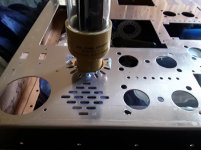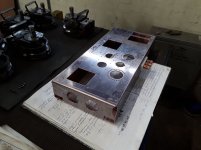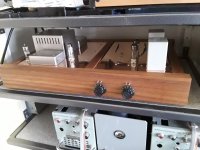I'm building a preamp with a copper top plate. I bought a sheet of copper on the 'net and cut out a rectangle using a hand held jig saw (easy). I then kludged together some bits and pieces so that I could hammer some bends along each edge to stiffen up the plate and help with mounting. I have cut out a square opening for a horizontally mounted power transformer and it's screw holes. That's as far as I've got. No issues working with it at all, of course it's different from working with Aluminum and Steel but I rather enjoy the change and chance to gain a little experience along the way.
Just go for it, you can always scrap it but you know how it goes 'nothing ventured is nothing gained'
better than nay sayers best advise so far,
Thinking things through, in a sane, reasonable, and intelligent way, is a good thing.
By intelligent, I mean having the fundamental basics learned and understood.
Things like Ohms Laws, color codes, wiring and lead-dress fundamentals, and reading up on proper wiring/grounding techniques.
Chassis/PCB layouts included.
Frequency properties, be it audio, or RF/IF, and how they react to outside influences, or interferences.
All these things (and more) must be in your toolbox (brain) before starting on a project.
Don't rely heavily on "internet" information, because a some of it can be mistaken or hyped, or confusing due to opinions of some.
Book publications are more accurate, without the plethora of internet suggestions.
But avoid "overthinking", because then it becomes a burden and clogs the mind.
i wonder, how is this related to the topic on hand? it is just a copper sheet, use it the same way you use steel or aluminum...i do not believe this required a lot of though, just time and money so if you have those, go go go...
Why would it improve sound? Ground plane that conducts better? For mechanical strength you could easily use plastic (Lexan or even acrylic).
No reason not to use a copper _PLATE_ ... That means to me 6mm+ (or 1/4") or it's _NOT_ plate. Plate != sheet.
It will eventually turn green like the Statue of Liberty if not coated with something, but it will work mechanically and electrically.
i used 1.5mm thick copper sheet....reinforced with 16 x 16mm by 2mm aluminum angle bar in the correct place...
on thing for sure, the plate is heavier than aluminum that i am used to working with...
For conductivity without restriction on thickness, it really comes down to cost. Aluminum twice as thick as copper will conduct better and cost less. Most electric distribution is on Aluminum until it goes up inside your walls to many-many outlets.
Steel is a very good conductor for some purposes. Around here we run 3/8" steel along the streets. Plenty of electric conductivity and some resistance to tree branches. If you need to worry about floppy tubes and saggy transformers, thick steel is one way to go (thick Aluminum is easier to DIY machine).
Steel is a very good conductor for some purposes. Around here we run 3/8" steel along the streets. Plenty of electric conductivity and some resistance to tree branches. If you need to worry about floppy tubes and saggy transformers, thick steel is one way to go (thick Aluminum is easier to DIY machine).
Steel rusts away in no time. Steel-cored aluminium is what overhead cables are made from, since you get the strength, corrosion-resistance and the conductance - best of all worlds.
Pure annealed aluminium is about as nasty to machine as copper - if you've ever made the mistake of getting this instead of a decent free-machining aluminium alloy you'll know this! Most of what people call aluminium in real-world uses is in fact one of the many precipitation-hardening aluminium alloys (there are many of these, some are better for corrosion resistance, some better for welding, some better for machining, some are stronger, some have better conductivity...).
Anyway anythings better than titanium to work with!
Pure annealed aluminium is about as nasty to machine as copper - if you've ever made the mistake of getting this instead of a decent free-machining aluminium alloy you'll know this! Most of what people call aluminium in real-world uses is in fact one of the many precipitation-hardening aluminium alloys (there are many of these, some are better for corrosion resistance, some better for welding, some better for machining, some are stronger, some have better conductivity...).
Anyway anythings better than titanium to work with!
Hello,
I made some chassis from mirror like copper which i polish once a year or so with the product used for brass instruments. When i need to handle the chassis ( which very rarely happens) i use a kind of cotton mittens.
I added all the holes with CNC punching machine at work.
Greetings, eduard
P.s material comes with a plastic coating that is removed after machining.
I made some chassis from mirror like copper which i polish once a year or so with the product used for brass instruments. When i need to handle the chassis ( which very rarely happens) i use a kind of cotton mittens.
I added all the holes with CNC punching machine at work.
Greetings, eduard
P.s material comes with a plastic coating that is removed after machining.
Attachments
I'm building a preamp with a copper top plate. I bought a sheet of copper on the 'net and cut out a rectangle using a hand held jig saw (easy). I then kludged together some bits and pieces so that I could hammer some bends along each edge to stiffen up the plate and help with mounting. I have cut out a square opening for a horizontally mounted power transformer and it's screw holes. That's as far as I've got. No issues working with it at all, of course it's different from working with Aluminum and Steel but I rather enjoy the change and chance to gain a little experience along the way.
Just go for it, you can always scrap it but you know how it goes 'nothing ventured is nothing gained'
Ya know, this is correct. I may just go for it. I need to order the kit first to take measurements of the top plate.better than nay sayers best advise so far,
They are easy to work, but not without raising large burrs, and bending the sheets inadvertently - things that make a professional finish difficult to achieve, and which aren't a problem with many other metals. Machinability is about achieving accurate and repeatable shapes, not just removing metal!
experience teaches you how to avoid such pitfalls....after all, common sense is never taught in any school, except in the school of hard knocks...
Apart from price and care requirements, I don't see much that counts against copper. It was in common use for VHF and UHF amateur radio gear chassis back in the tubes era and I dare say, some commercial and military applications too. (see examples in ARRL annual handbook editions from the '60s-'80s)
Sheet brass was widely used too but the important metallic property to note is the hardness of the stock material. Most commonly, copper is sold in half-hard or HO2 grade and goes up to brittle, unworkable HO4 if you shop around. Handling of the softer grades must be with care and protection or the flat polished surface you hope to see won't be flat at all and actually look amateurish. Fundamentals: Types of Copper and Properties
I should add that a hard lacquer coating is needed to prevent rapid discolouring and corrosion of the bare surfaces and you may need to temper (soften) the metal to work it without weakening it as you fold flanges, form eyes etc.
Sheet brass was widely used too but the important metallic property to note is the hardness of the stock material. Most commonly, copper is sold in half-hard or HO2 grade and goes up to brittle, unworkable HO4 if you shop around. Handling of the softer grades must be with care and protection or the flat polished surface you hope to see won't be flat at all and actually look amateurish. Fundamentals: Types of Copper and Properties
I should add that a hard lacquer coating is needed to prevent rapid discolouring and corrosion of the bare surfaces and you may need to temper (soften) the metal to work it without weakening it as you fold flanges, form eyes etc.
Last edited:
- Home
- Design & Build
- Parts
- Is there a downside to a copper top plate for a tube amp?


